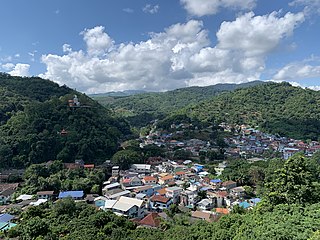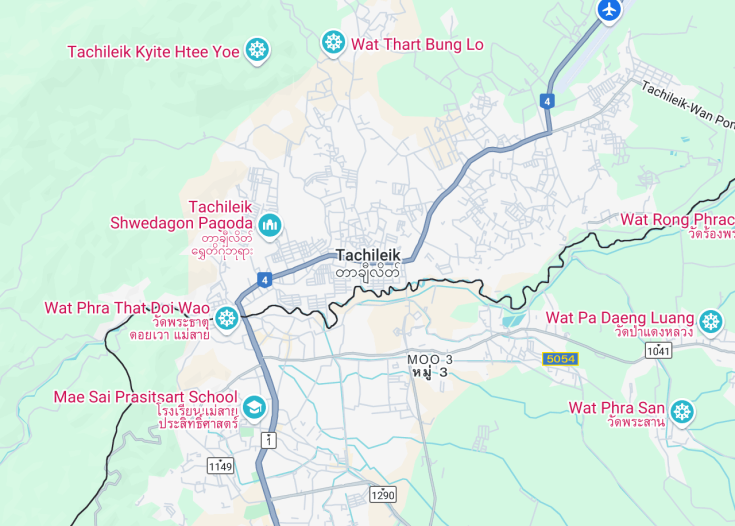Nestled at the edge of Myanmar and Thailand, Tachileik is a fascinating border town brimming with vibrant markets and rich cultural experiences. Known for its bustling border-crossing point, the town offers a unique blend of Burmese and Thai influences, making it a captivating destination for adventurous travelers. From exploring local temples to indulging in cross-cultural cuisine, Tachileik provides a rare glimpse into the day-to-day life at a dynamic frontier.
Be sure to visit the Shwedagon Pagoda replica, an impressive site that offers insight into Tachileik’s religious significance and architectural beauty.
Consider timing your visit during a local festival to experience Tachileik’s vibrant community spirit and traditional performances firsthand.
Top things to do & see in Tachileik
Select the following sights and activities to discover best tickets and tours available in Tachileik.
Tachileik: A Gateway to Cultures and Commerce
| Country | Myanmar |
| Time in Tachileik | GMT+6:30 |
| Language spoken | Burmese |
| Population | 51,553 (Census 2024) |
| Currency | Burmese kyat (K) (MMK) |
| Airports |
|
Located on the eastern border of Myanmar, Tachileik serves as an essential nexus of trade and culture, bridging the diverse landscapes and communities of Myanmar and Thailand. This town offers a unique glimpse into the local traditions and economic activities that define the border regions of Southeast Asia. From bustling markets filled with handicrafts and local delicacies to serene temples, Tachileik offers an inviting mix of adventure and tranquility.
Historically, Tachileik has been instrumental in facilitating trade across Southeast Asia. It has also seen its fair share of conflict and cooperation as various governmental and ethnic forces negotiated its strategic importance. Today, Tachileik is seeing moderate urban growth and plays a significant role in the cultural exchange between the Myanmar people and their neighbors. Advancements in infrastructure, such as the development around Tachileik Airport, have made the city more accessible to tourists and business travelers alike.
The city’s proximity to Thailand and its position along major trading routes have naturally imbued Tachileik with a vibrant, hybrid culture and a bustling economy. The Tham Pla–Pha Suea National Park nearby offers nature enthusiasts breathtaking landscapes and wildlife expeditions, further boosting the town’s tourism sector. Tachileik’s markets are known for their silver crafts, textiles, and gemstones, reflecting the town’s rich artisanal traditions. The locality is also celebrated for its festivals, particularly the vibrant water festival of Songkran which attracts thousands of visitors annually.
Life in Tachileik exudes a delicate balance between traditional practices and the pressures of modern development, providing a fascinating study of resilience and adaptation. With continued focus on sustainable growth and cross-border cooperation, Tachileik stands to enhance further its regional significance in the coming years.
Where is Tachileik?
Tachileik is situated in the Shan State of eastern Myanmar, bordering northern Thailand.
Distances:
| Route | Distance by car | Time by car |
|---|---|---|
| Yangon to Tachileik | 450 mi | 12 hrs approx. |
| Mandalay to Tachileik | 560 mi | 14 hrs approx. |
What is Tachileik famous for?
Tachileik is renowned for its bustling border market economy, rich tradition of handicrafts, and vibrant festivals that showcase the local culture and heritage.
History
Prehistoric to Early Modern Period (before 1600)
Tachileik, known for its strategic location at the eastern border of Myanmar, has a storied history that dates back to prehistoric times. It was part of the historic Lanna Kingdom and later influenced by the Tai cultures and Burmese kingdoms, serving as a critical point of cultural interchange and trade.
1600 – 1885: Burmese Kingdoms and Conflict
During this period, Tachileik was often at the center of regional power struggles. It frequently changed hands between the Burmese, Thai, and occasionally, Laotian forces. These frequent changes in control helped forge Tachileik’s diverse cultural tapestry but also brought about frequent conflicts and disruptions in local governance.
1885 – 1948: Colonial Era to Independence
With the British annexation of Burma in 1885, Tachileik fell under British rule. This period introduced colonial architecture and infrastructure developments. Post World War II, Tachileik became part of the newly independent Union of Burma in 1948, marking a significant transition from colonial rule to self-governance.
1948 – Present: Modern Developments
The latter half of the 20th century and early 21st century saw Tachileik develop as a gateway for trade between Myanmar and Thailand. Despite occasional conflicts due to its border location, Tachileik has strived towards economic development, focusing on tourism and cross-border commerce, amidst the backdrop of Myanmar’s complex political landscape.
Visit Tachileik
What to see and do in Tachileik
Tachileik offers a mix of cultural heritage and scenic landscapes. Key attractions include:
- The Shwedagon Pagoda, a replica of Yangon’s famous golden stupa.
- Mae Sai Market, perfect for experiencing local trade and culture.
- The cultural villages surrounding Tachileik, showcasing the traditional lifestyles of various ethnic groups.
- Natural reserves and waterfalls, ideal for nature enthusiasts.
These destinations provide a deep insight into both the modern day dynamics and the historical tapestry of Tachileik.
Local Festivals in Tachileik
Recurring cultural events in Tachileik include the Water Festival in April, celebrating the Myanmar New Year with water fights and street festivals, and the Light Festival in November, where locals light thousands of oil lamps, floating them on water bodies to signify the victory of good over evil.
Best time to visit Tachileik
The best time to visit Tachileik is between November and February when the weather is cooler and drier, making it ideal for exploring the outdoor attractions and participating in local festivals.
is Tachileik worth visiting?
Tachileik, with its rich history and cultural diversity, offers a unique glimpse into the border dynamics of Myanmar and Thailand. It’s appealing for those interested in cultural studies and traditional marketplaces. However, visitors may face challenges related to transportation and occasional political tensions in the border area. Despite this, for those who seek a deeper understanding of Myanmar’s cultural and historical complexities, Tachileik is certainly worth a visit.









